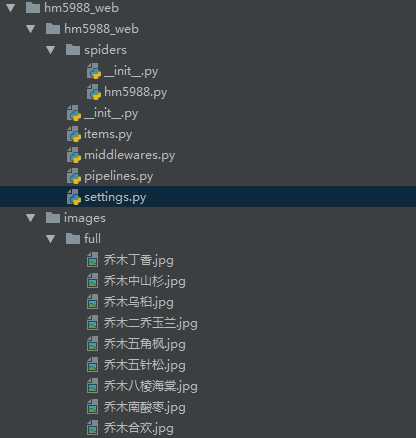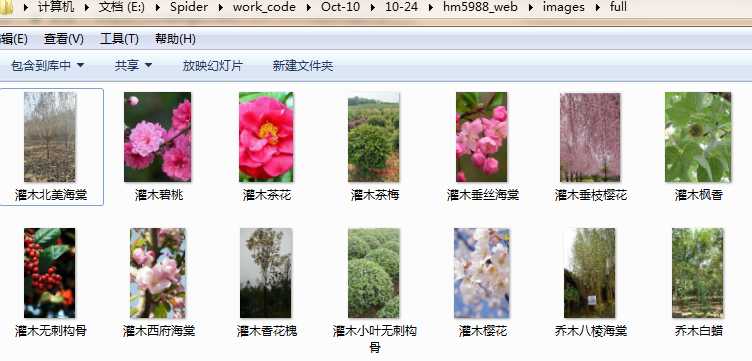标签:item rri format 产品 llb object scrapy cli ems
解决图片下载重命名保存本地,直接上代码(在原来代码做了一定的修改)。
总结:主要就是添加配置一个内置的函数,对保存的东西进行修改再存储,主要问题还是再piplines的设置里面。
效果如图:


hm5988.py
# -*- coding: utf-8 -*- import scrapy from hm5988_web.items import Hm5988WebItem class Hm5988Spider(scrapy.Spider): name = ‘hm5988‘ allowed_domains = [‘www.hm5988.com‘] start_urls = [‘http://www.hm5988.com/goods/CATE0.html?page=1‘] custom_settings = { ‘DOWNLOAD_DELAY‘: 0.5, "ITEM_PIPELINES": { ‘hm5988_web.pipelines.ImagePipeline‘: 300, ‘hm5988_web.pipelines.MysqlPipeline‘: 302, }, "DOWNLOADER_MIDDLEWARES": { ‘hm5988_web.middlewares.Hm5988WebDownloaderMiddleware‘: 500, }, } def parse(self, response): # 获取页码 p_url = response.xpath("//li[@class=‘last‘]/a/@href").extract_first() page_num = p_url.split(‘=‘)[1] # print(page_num) for i in range(2, int(page_num)+1): url = ‘http://www.hm5988.com/goods/CATE0.html?page={}‘.format(i) yield scrapy.Request(url=url, callback=self.parse_detail) def parse_detail(self,response): link_urls = response.xpath("//li[@class=‘mr10 mb20‘]/a/@href").extract() for link_url in link_urls: # print(link_url) yield scrapy.Request(url=link_url, callback=self.parse_detail2) def parse_detail2(self, response): item = Hm5988WebItem() # 所属分类 _type = response.xpath("//div[@class=‘current‘]/a[6]/text()").extract_first() item[‘_type‘] = _type # 产品名称 name = response.xpath("//div[@class=‘txt-t fl‘]/li[@class=‘fs22 gc3 fw‘]/text()").extract_first() item[‘name‘] = name # 详情图片 pic = response.xpath("//div[@class=‘pic-box fl p10‘]/img[@class=‘pic-big‘]/@src").extract_first() item[‘pic‘] = pic yield item print(‘*‘*100)
items.py # -*- coding: utf-8 -*- # Define here the models for your scraped items # # See documentation in: # https://doc.scrapy.org/en/latest/topics/items.html import scrapy class Hm5988WebItem(scrapy.Item): # define the fields for your item here like: # name = scrapy.Field() # 所属分类 _type = scrapy.Field() # 产品名称 name = scrapy.Field() # 详情图片 pic = scrapy.Field()
middlewares.py # -*- coding: utf-8 -*- # Define here the models for your spider middleware # # See documentation in: # https://doc.scrapy.org/en/latest/topics/spider-middleware.html from scrapy import signals class Hm5988WebSpiderMiddleware(object): # Not all methods need to be defined. If a method is not defined, # scrapy acts as if the spider middleware does not modify the # passed objects. @classmethod def from_crawler(cls, crawler): # This method is used by Scrapy to create your spiders. s = cls() crawler.signals.connect(s.spider_opened, signal=signals.spider_opened) return s def process_spider_input(self, response, spider): # Called for each response that goes through the spider # middleware and into the spider. # Should return None or raise an exception. return None def process_spider_output(self, response, result, spider): # Called with the results returned from the Spider, after # it has processed the response. # Must return an iterable of Request, dict or Item objects. for i in result: yield i def process_spider_exception(self, response, exception, spider): # Called when a spider or process_spider_input() method # (from other spider middleware) raises an exception. # Should return either None or an iterable of Response, dict # or Item objects. pass def process_start_requests(self, start_requests, spider): # Called with the start requests of the spider, and works # similarly to the process_spider_output() method, except # that it doesn’t have a response associated. # Must return only requests (not items). for r in start_requests: yield r def spider_opened(self, spider): spider.logger.info(‘Spider opened: %s‘ % spider.name) class Hm5988WebDownloaderMiddleware(object): # Not all methods need to be defined. If a method is not defined, # scrapy acts as if the downloader middleware does not modify the # passed objects. @classmethod def from_crawler(cls, crawler): # This method is used by Scrapy to create your spiders. s = cls() crawler.signals.connect(s.spider_opened, signal=signals.spider_opened) return s def process_request(self, request, spider): # Called for each request that goes through the downloader # middleware. # Must either: # - return None: continue processing this request # - or return a Response object # - or return a Request object # - or raise IgnoreRequest: process_exception() methods of # installed downloader middleware will be called return None def process_response(self, request, response, spider): # Called with the response returned from the downloader. # Must either; # - return a Response object # - return a Request object # - or raise IgnoreRequest return response def process_exception(self, request, exception, spider): # Called when a download handler or a process_request() # (from other downloader middleware) raises an exception. # Must either: # - return None: continue processing this exception # - return a Response object: stops process_exception() chain # - return a Request object: stops process_exception() chain pass def spider_opened(self, spider): spider.logger.info(‘Spider opened: %s‘ % spider.name)
piplines.py # -*- coding: utf-8 -*- # Define your item pipelines here # # Don‘t forget to add your pipeline to the ITEM_PIPELINES setting # See: https://doc.scrapy.org/en/latest/topics/item-pipeline.html from scrapy.conf import settings from scrapy import Request from scrapy.exceptions import DropItem from scrapy.pipelines.images import ImagesPipeline import pymysql class Hm5988WebPipeline(object): def process_item(self, item, spider): return item # 数据保存mysql class MysqlPipeline(object): def open_spider(self, spider): self.host = settings.get(‘MYSQL_HOST‘) self.port = settings.get(‘MYSQL_PORT‘) self.user = settings.get(‘MYSQL_USER‘) self.password = settings.get(‘MYSQL_PASSWORD‘) self.db = settings.get((‘MYSQL_DB‘)) self.table = settings.get(‘TABLE‘) self.client = pymysql.connect(host=self.host, user=self.user, password=self.password, port=self.port, db=self.db, charset=‘utf8‘) def process_item(self, item, spider): item_dict = dict(item) cursor = self.client.cursor() values = ‘,‘.join([‘%s‘] * len(item_dict)) keys = ‘,‘.join(item_dict.keys()) sql = ‘INSERT INTO {table}({keys}) VALUES ({values})‘.format(table=self.table, keys=keys, values=values) try: if cursor.execute(sql, tuple(item_dict.values())): # 第一个值为sql语句第二个为 值 为一个元组 print(‘数据入库成功!‘) self.client.commit() except Exception as e: print(e) self.client.rollback() return item def close_spider(self, spider): self.client.close() class ImagePipeline(ImagesPipeline): def item_completed(self, results, item, info): image_paths = [x[‘path‘] for ok, x in results if ok] if not image_paths: raise DropItem(‘Image Downloaded Failed‘) return item def get_media_requests(self, item, info): yield Request(item[‘pic‘], meta={‘item‘:item}) def file_path(self, request, response=None, info=None): item = request.meta[‘item‘] filename = u‘full/{}.jpg‘.format(item[‘name‘]) return filename
settings.py # -*- coding: utf-8 -*- # Scrapy settings for hm5988_web project # # For simplicity, this file contains only settings considered important or # commonly used. You can find more settings consulting the documentation: # # https://doc.scrapy.org/en/latest/topics/settings.html # https://doc.scrapy.org/en/latest/topics/downloader-middleware.html # https://doc.scrapy.org/en/latest/topics/spider-middleware.html BOT_NAME = ‘hm5988_web‘ SPIDER_MODULES = [‘hm5988_web.spiders‘] NEWSPIDER_MODULE = ‘hm5988_web.spiders‘ IMAGES_STORE = ‘./images‘ # Crawl responsibly by identifying yourself (and your website) on the user-agent #USER_AGENT = ‘hm5988_web (+http://www.yourdomain.com)‘ # Obey robots.txt rules # Obey robots.txt rules ROBOTSTXT_OBEY = False # mysql配置参数 MYSQL_HOST = "172.16.10.157" MYSQL_PORT = 3306 MYSQL_USER = "root" MYSQL_PASSWORD = "123456" MYSQL_DB = ‘web_datas‘ TABLE = "hm5988_2" # Configure maximum concurrent requests performed by Scrapy (default: 16) #CONCURRENT_REQUESTS = 32 # Configure a delay for requests for the same website (default: 0) # See https://doc.scrapy.org/en/latest/topics/settings.html#download-delay # See also autothrottle settings and docs #DOWNLOAD_DELAY = 3 # The download delay setting will honor only one of: #CONCURRENT_REQUESTS_PER_DOMAIN = 16 #CONCURRENT_REQUESTS_PER_IP = 16 # Disable cookies (enabled by default) #COOKIES_ENABLED = False # Disable Telnet Console (enabled by default) #TELNETCONSOLE_ENABLED = False # Override the default request headers: #DEFAULT_REQUEST_HEADERS = { # ‘Accept‘: ‘text/html,application/xhtml+xml,application/xml;q=0.9,*/*;q=0.8‘, # ‘Accept-Language‘: ‘en‘, #} # Enable or disable spider middlewares # See https://doc.scrapy.org/en/latest/topics/spider-middleware.html #SPIDER_MIDDLEWARES = { # ‘hm5988_web.middlewares.Hm5988WebSpiderMiddleware‘: 543, #} # Enable or disable downloader middlewares # See https://doc.scrapy.org/en/latest/topics/downloader-middleware.html DOWNLOADER_MIDDLEWARES = { ‘hm5988_web.middlewares.Hm5988WebDownloaderMiddleware‘: 543, } # Enable or disable extensions # See https://doc.scrapy.org/en/latest/topics/extensions.html #EXTENSIONS = { # ‘scrapy.extensions.telnet.TelnetConsole‘: None, #} # Configure item pipelines # See https://doc.scrapy.org/en/latest/topics/item-pipeline.html ITEM_PIPELINES = { ‘hm5988_web.pipelines.ImagePipeline‘: 300, ‘hm5988_web.pipelines.Hm5988WebPipeline‘: 302, } # Enable and configure the AutoThrottle extension (disabled by default) # See https://doc.scrapy.org/en/latest/topics/autothrottle.html #AUTOTHROTTLE_ENABLED = True # The initial download delay #AUTOTHROTTLE_START_DELAY = 5 # The maximum download delay to be set in case of high latencies #AUTOTHROTTLE_MAX_DELAY = 60 # The average number of requests Scrapy should be sending in parallel to # each remote server #AUTOTHROTTLE_TARGET_CONCURRENCY = 1.0 # Enable showing throttling stats for every response received: #AUTOTHROTTLE_DEBUG = False # Enable and configure HTTP caching (disabled by default) # See https://doc.scrapy.org/en/latest/topics/downloader-middleware.html#httpcache-middleware-settings #HTTPCACHE_ENABLED = True #HTTPCACHE_EXPIRATION_SECS = 0 #HTTPCACHE_DIR = ‘httpcache‘ #HTTPCACHE_IGNORE_HTTP_CODES = [] #HTTPCACHE_STORAGE = ‘scrapy.extensions.httpcache.FilesystemCacheStorage‘
标签:item rri format 产品 llb object scrapy cli ems
原文地址:https://www.cnblogs.com/lvjing/p/9842656.html